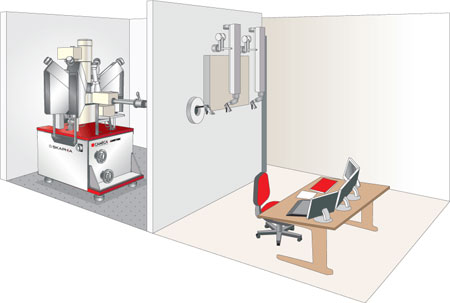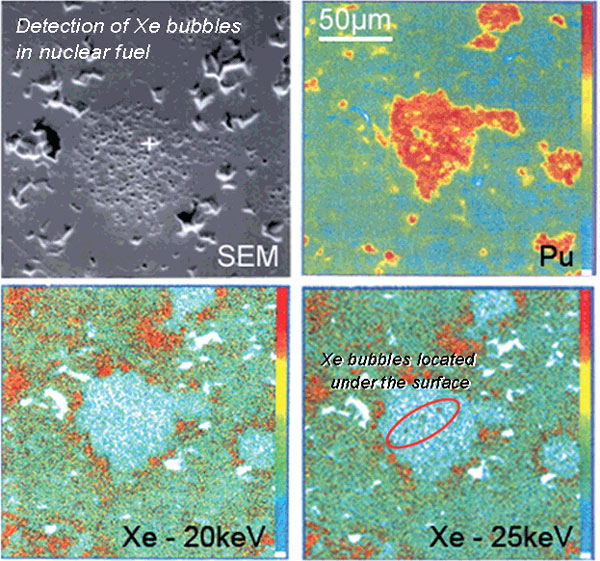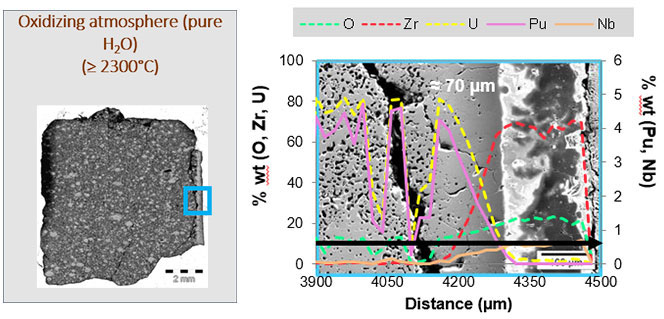CAMECA SKAPHIA
Shielded EPMA for radioactive materials
The CAMECA SKAPHIA is an EPMA (Electron Probe MicroAnalyser) for safely manipulating and analysing nuclear samples.
SKAPHIA gives you compositional information about radioactive materials:
- Analyse almost all elements on the periodic table.
- Detect major and trace elements.
- Sub-micron resolution.
- Suitable for samples emitting beta and gamma radiation.
- Maximum acceptable g radiation level:
111 GBq at an energy of 0.75 MeV.
Gain a deeper understanding of fuel performance, explore irradiated material behaviour and radiation damage processes, develop new alloys and structural materials, optimise the nuclear fuel cycle, improve nuclear waste management and more.
Contact us for more information and quotes:
+44 (0)1223 422 269 or info@blue-scientific.com

Designed for Radiactive Materials
The column, spectrometers and sample stage are installed in a hot cell (lead or concrete shielded room). The electronics and computer are situated outside this room. The instrument is fully remote-controlled, including the stage, column and diaphragms. Samples are inserted and mounted safely using remote manipulators and/or ball manipulators.
All WDS analysers and detectors are shielded to prevent background caused by gamma radiation. The stage is made of Denal material. The secondary electron detector is oriented to avoid gamma ray perturbation.
CAMECA’s dedicated EPMA software gives you all the tools you need for quantitative analysis, X-ray mapping, line profile acquisition and data processing.
Example Applications
CAMECA is a world leader in shielded EPMA, with over a dozen instruments in operation worldwide.
- Study radiation damage processes in materials and complex micro-structures
- Analyse of materials for the nuclear fuel cycle
- Advanced alloys and structural materials R&D
- Nuclear reactor maintenance optimisation
- Nuclear waste management
- … and more

Case Study: Nuclear Safety Programme
The international VERDON-ISTP programme aims to reduce the risks of radioactive emissions in the case of a severe nuclear accident.
One of their studies involves heating fuel pellets to an extremely high temperature and monitoring the release of fission products. Data about the micro-structure and chemical composition of the nuclear fuel under final atmosphere (oxidising or reducing) is used to predict its behaviour in an accident.
Shielded EPMA is used to characterise the distribution and chemical composition of fission products in various phases.
In this example, EPMA was used to analyse interaction between the nuclear fuel and cladding materials. Under oxidising conditions, interdiffusion of U and Zr takes place at the interface between the fuel and the cladding. Quantitative profiles reveal an interdiffusion distance of approximately 70 µm.
Shielded EPMA was also used to study a molten zone (U, Pu, Zr)O2 penetrating the crack of a pellet under reducing atmosphere, and investigate the impact of the atmosphere on fission product speciation (‘white inclusions’ composed of metallic Mo, Ru, Rh, Pd and Tc).
Data from CEA Cadarache, France (CEA / DES / IRESNE / DEC / SA3E)
Le Gall et al., Journal of Nuclear Materials 530 (2020) 151948
Le Gall et al., Journal of Nuclear Materials 531 (2020) 152015


